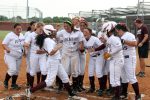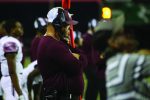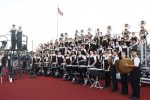LHS grad seeks stories of ‘black baseball’ in Caldwell County
By Greg Garrett
Special to the POST-REGISTER
The history of segregation in Texas is not one that we like to remember. It isn’t the “pretty face” that we like to project to the rest of the country. Though history isn’t always pretty, it still cannot be ignored. Segregation of the white and black populations during the volatile de
cades of the 1930s through the early 1960s was an unfortunate social occurrence. It affected where people could eat or drink water, where they could dance, where they could use the restroom and even which baseball teams they could play on. That’s right, baseball did not escape the realities of this social ill.
Despite this separation of black players and teams into their own leagues and playing circuits the sport became a favorite competitive pastime for the black community. It became so popular that one of our own, Rube Foster, born in Caldwell County, established the Chicago American Giants and the Negro National League in 1920. This was the first organized, professional league for the greatest colored players of the time. Foster’s pioneering ways were the foundation for the great Negro League teams like the Kansas City Monarchs and Pittsburgh Crawfords. Some of the best players the game has ever seen took the field in this league. Men like Josh Gibson, Willie “El Diablo” Wells, Satchell Paige and, in its later years, greats like Jackie Robinson, Larry Doby and Willie Mays. These were true stars of the game. Men that black children throughout the country recognized as their own and took pride in their player’s accomplishments.
While the Negro Professional Leagues were offering blacks opportunities on a national level, the game was just as popular and important on the city and small town levels. Baseball had permeated the country by the 1940s, and people all ages and backgrounds were exposed to the game. This holds true for black communities in cities and small towns across Texas. Places like San Antonio, Austin and Houston had several black teams that often played in their own leagues. These city teams had another adversary on the diamond: small town teams like Kerrville, Seguin, Abilene and, yes, Lockhart.
Did you play on one of these teams in Lockhart or one of our surrounding communities: Dale, Maxwell, McMahan? Did you ever watch the St. John Lions or the Ebon team play a game on the field in Luling? Did you ever make a trip to watch the boys from Lockhart take on the Bastrop Tigers? If any of this rings a bell, we need to talk.
I am currently researching the topic of amateur black baseball teams during segregation in Texas. This focus will be the topic of two programs that I will be organizing at the UTSA Institute of Texan Cultures in San Antonio. My goal is to help people understand how important baseball was as a tool of social inclusion. I feel strongly that baseball was transcendent within local communities and played a major role in breaking down racial stereotypes all the way up to the national level.
It is my hope that those who read this article or played on one of the black amateur teams in Lockhart will have stories to share. I am collecting oral histories, photos and newspaper clippings on this subject. The material will be saved and archived into the collection at the museum. Grandchildren and great-grandchildren will be able to hear stories of history makers in their families and communities.
Please help me to save personal accounts of these often untold and unheard stories. We must remember that all points of history converge to bring us where we are today. We must remember that all stories and accounts are important to the narrative of Texas and that we have all played a part in creating the tapestry of culture that is our great state. Thank you and I hope to hear from you soon.
Greg Garrett
(210) 458-2225
(210) 861-6820
Gregory.garrett@utsa.edu
Greg Garrett works as an Education Specialist with UTSA’s Institute of Texan Cultures. Garrett’s work within the Education and Interpretation Department focuses on researching content for programming and interpretive tours. Garrett is also a Certified Interpretive Guide through the National Association of Interpretation. Himself a baseball player, Garrett graduated Lockhart High School with the Class of 1992. histories, photos and newspaper clippings on this subject. The material will be saved and archived into the collection at the museum. Grandchildren and great-grandchildren will be able to hear stories of history makers in their families and communities.



